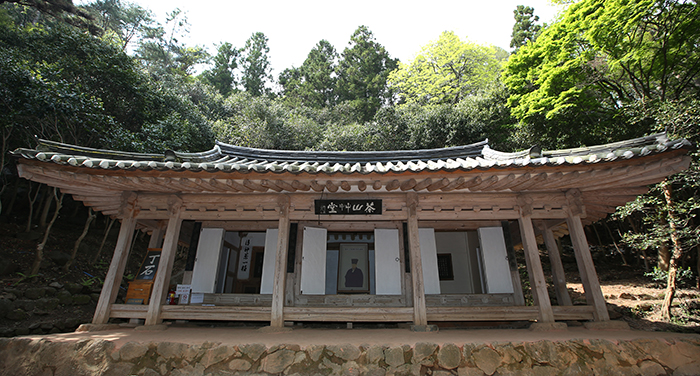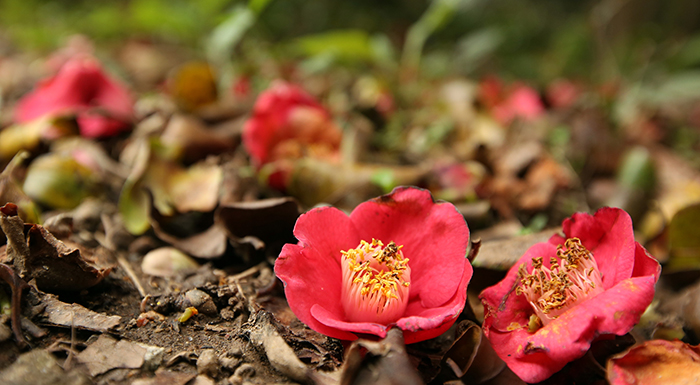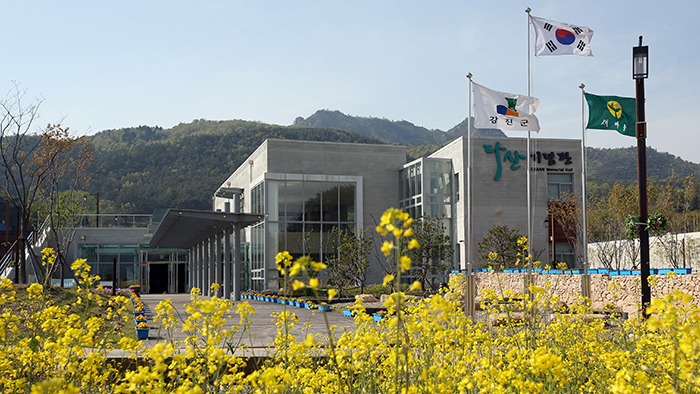Green leaves, flowers decorate Gangjin
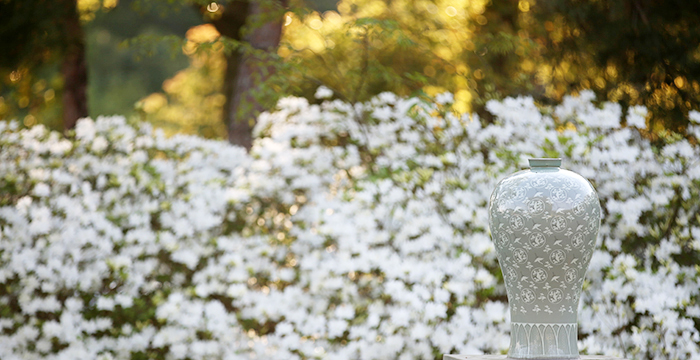 Against a backdrop of flowers, a replica Goryeo celadon vase shines its brilliant blue-green colors in the front garden of the Gangjin Celadon Museum.
Against a backdrop of flowers, a replica Goryeo celadon vase shines its brilliant blue-green colors in the front garden of the Gangjin Celadon Museum.
Gangjin was the production site of much of the iconic blue-green celadon crafted during Goryeo times (918-1392). Home to many green tea trees, the city is always colored in green throughout the year along with the blue of the South Sea.
It used to only be possible to see Goryeo celadon through the glass of the museum case, but in Gangjin, people can directly appreciate the iconic ceramic style’s green color outdoors. When entering the grounds of the Gangjin Celadon Museum, blue-green colors shine from celadon replicas, from a pavilion made with blue-green tiles and from celadon bells that hang from the edge of the eaves. In the museum, visitors can learn more about Goryeo celadon pottery through the pieces on display, which show a continuous development in color and pattern according to time period.
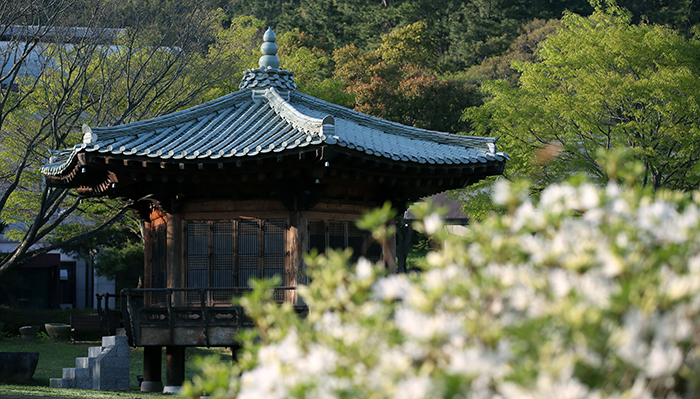 Made with blue tiles, the Gyeryongjeong Pavilion is located in the front gardens of the Gangjin Celadon Museum. This pavilion is a replica of the Yangyijeong Pavilion which stood in Gaegyeong, today’s Gaeseong, during Goryeo times (918-1392) and which was built during the reign of King Euijong (1127-1173).
Made with blue tiles, the Gyeryongjeong Pavilion is located in the front gardens of the Gangjin Celadon Museum. This pavilion is a replica of the Yangyijeong Pavilion which stood in Gaegyeong, today’s Gaeseong, during Goryeo times (918-1392) and which was built during the reign of King Euijong (1127-1173).
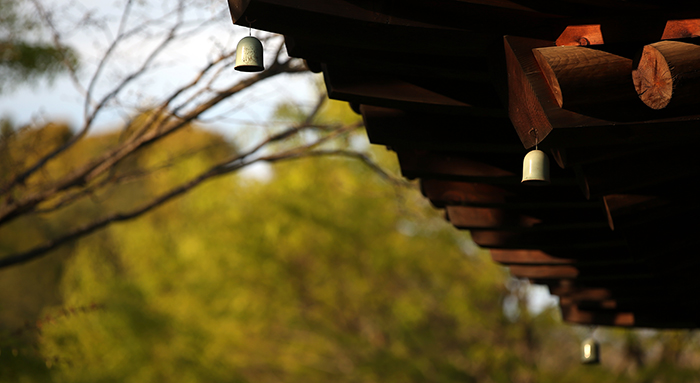 Celadon bells hang from the edge of the eaves of a pavilion on the grounds of the Gangjin Celadon Museum.
Celadon bells hang from the edge of the eaves of a pavilion on the grounds of the Gangjin Celadon Museum.
At the museum, people can do more than just inspect Goryeo celadon. They can see first-hand how potters make celadon pottery by going through various steps and procedures, such as shaping the pottery using a potter’s wheel and placing the inlaid decoration. Visitors can make their own pieces of pottery and get them delivered to their home, too. They can also purchase various Goryeo celadon replicas for their family or friends.
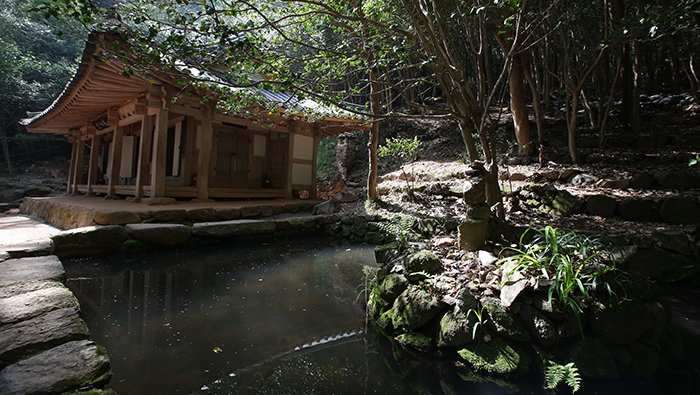 The Dasan Chodang is located at the foot of Mandeoksan Mountain in Gangjin. This house is where Jeong Yak-yong, pen name Dasan (1762-1836), a well-known scholar from late Joseon times, fostered younger students and wrote about 600 books during his exile.
The Dasan Chodang is located at the foot of Mandeoksan Mountain in Gangjin. This house is where Jeong Yak-yong, pen name Dasan (1762-1836), a well-known scholar from late Joseon times, fostered younger students and wrote about 600 books during his exile.
When heading to Mandeoksan Mountain (408 meters) after the celadon museum, a trail leads people to the Dasan Chodang underneath green tea trees. Surrounded by deep blue-green leaves, the Dasan Chodang welcomes all visitors. This is where Jeong Yak-yong, pen name Dasan (1762-1836), a well-known scholar from late Joseon times, taught younger students and wrote approximately 600 books, such as “Mokminsimseo” (“목민심서,” “牧民心書”), “The Mind of Governing the People” (“Gyeongse Yupyo,” “경세유표,” “經世遺表”), “Design for Good Government” and “Heumheumsinseo” (“흠흠신서,” “欽欽新書”) during his exile here.
Walking along the path that connects the Dasan Memorial Hall, the Dasan Chodang and Baengnyeonsa Temple, people can enjoy the fresh air while walking under the green leaves and bright sunshine. As the mountain is neither high nor steep, this path is also good for those who prefer easier hiking trails, or for seniors.
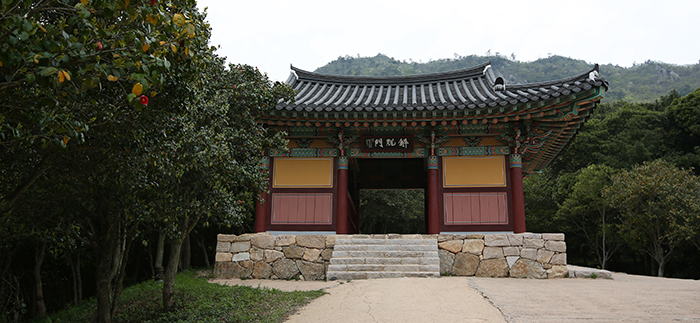 The path from the entrance of Baengnyeonsa Temple to the Daeung Bojeon building is surrounded by a forest of camellia trees.
The path from the entrance of Baengnyeonsa Temple to the Daeung Bojeon building is surrounded by a forest of camellia trees.
Baengnyeonsa Temple, close to the Dasan Chodang, is famous for its flower path. The forest of camellia trees creates a picturesque view, especially when the flowers are in bloom in early spring and when they fall onto the path in early April. The petals and flowers fallen from about 1,500 camellia trees make us feel as if a red carpet has been laid on the forest floor. The people of Gangjin say that spring is in the air when the camellia flowers at this temple fall to the ground. Gangjin may be the only place where springtime picnickers can see such fallen flowers.
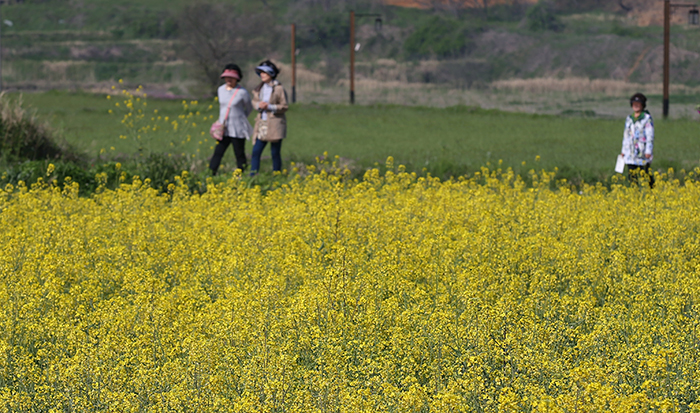 Canola flowers in front of the Dasan Memorial Hal in Gangjin County make visitors feel alive and happy.
Canola flowers in front of the Dasan Memorial Hal in Gangjin County make visitors feel alive and happy.
When the forest paths of Baengnyeonsa Temple are colored in red, a yellow sea unfolds in front of the Dasan Memorial Hall at the mountain’s base. A field of canola flowers covers some 8,200 square meters and becomes a must-see attraction for tourists visiting Gangjin County in the spring. Some people walk among the waves of yellow flowers, slowly moving along in the spring breeze. They take photos with their friends on their mobile phones. Others walk through the flower beds, or are busy sharing photos with their family or friends online.
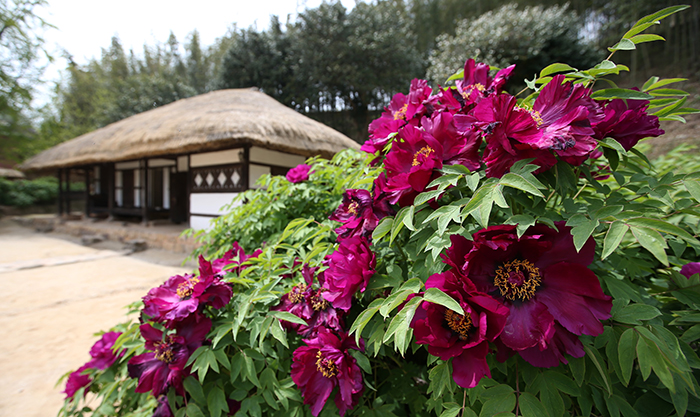 The birthplace of Yeongnang Kim Yun-sik is decorated with peonies which bloom with big, splendid buds for a short period in early spring.
The birthplace of Yeongnang Kim Yun-sik is decorated with peonies which bloom with big, splendid buds for a short period in early spring.
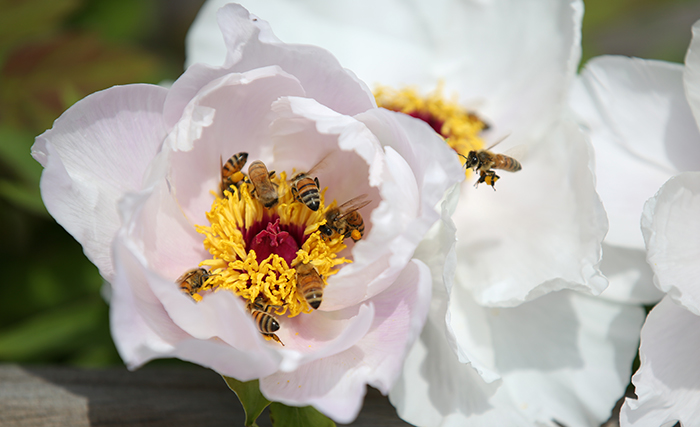 Bees are busy collecting pollen and nectar from a white peony. They seem to be captivated by the splendor of the peonies in full bloom.
Bees are busy collecting pollen and nectar from a white peony. They seem to be captivated by the splendor of the peonies in full bloom.
There is another must-see flower in Gangjin apart from the camellia and canola flowers: the peony. Peonies in full bloom in various colors greet visitors to the birthplace of poet Yeongnang Kim Yun-sik, pen name Yeongnang (1903–1950). He is best known for his poem “Until Peonies Bloom.”
There is a story about peonies in Korean history. When she received a painting of peonies from the Chinese Tang court, Queen Seondeok (?-647) of Silla pointed out that the flower does not have any fragrance. The flower is known to have come to Korea during the reign of Silla King Jinpyeong (?-632).
As peonies are in bloom for only a brief period of time, it is not easy to see them in front of the birthplace of the poet. According to a cultural heritage commentator, those who see a peony in full bloom have great luck, as everything has to be just perfect to see the flowers, such as the climate and the weather.
Gangjin County has created the World Peony Park behind the birthplace of the poet where people can see various peony varieties from around the globe.
Article by Jeon Han, Yoon Sojung
Photos: Jeon Han
Korea.net Staff Writers
hanjeon@korea.kr

